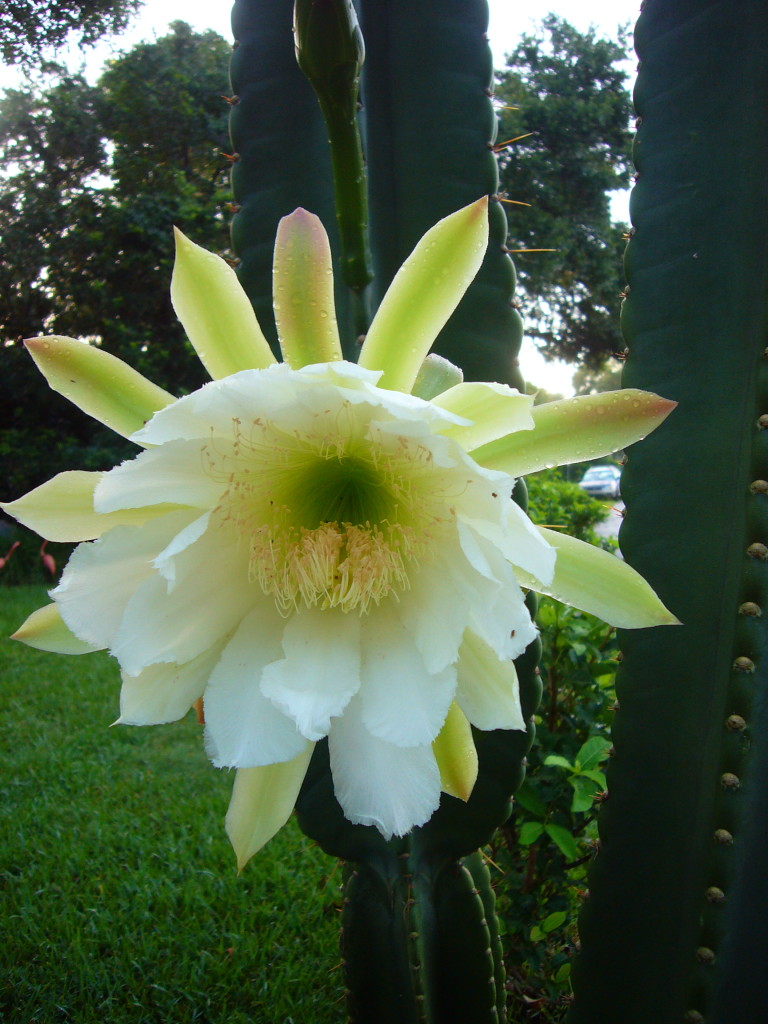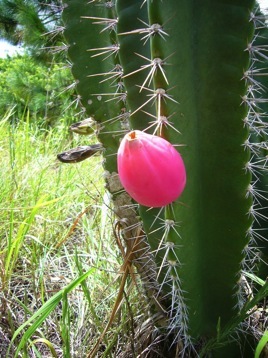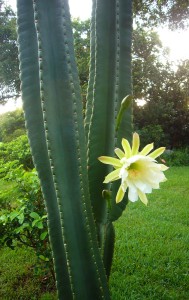Getting Down To Cereus Business
There are three things irritating about Cereus other than their spines: 1) several botanical names for the same plant; 2) which species do you exactly have, and 3) how you pronounce “Cereus.”
DNA testing may indeed be reducing crime but it is increasing cactuses, or at least changing their names. Many “cereus” are no longer cereus, among them C. undatus, C. pentagonus, C. robinii and C. keyensis, or as they are now known Hylocereus undatus, Acanthocerus tratragonus, Pilosocerus polygonus, and Pilosocereus robinii. Do those name changes clear things up? … Thought so….
The last three are found only in southern Florida or the Keys and are endangered. Just know they are sprawling, usually three sided, and fruit’s pulp is edible raw if you are starving, just spread the seeds around. Also endangered in Florida is the C. eriophorus var. fragrans, C. gracilis var aboriginum, C. simpsonii and C. deeringii. The H. undatus (aka C. triangularis & tricostatus) is naturalized up to coastal central Florida and planted inland, such as at Mead Gardens. It is a commercial crop called “Dragon Fruit.” Also eaten is Cereus giganteus, known more famously by its common name, Saguaro Cactus. (Now that Cereus is called Carnegiea gigantea.)
The fruit of cactus are used in similar ways. The Saguaro Cactus is a good example. It was a staple of the Papago and Pima Indians. They harvested the fruit in July. The fruit can be eaten fresh or dried. When dry they can be pressed into cakes. The juice was used to make moonshine and the seeds ground into a buttery paste. The fruits are also eaten of the C. hexagonus, C., jamacaru, C. pernambucensis, and the C. peruvianus, the latter is perhaps the most common ornamentally grown cactus in the world, if it really exists at all, as a species. An explanation is required.
While many cactus are sold with the name C. peruvianus some people aren’t even sure it really exists as a species and might actually be one or two other species, or some hybrid. The Cereus above has nine spines where as most pictures show them with seven. One Cereus with nine spines is C. jamacaru, but its fruit is oblong and the one above is not. Tis a puzzle. Fortunately, all Cereus fruits are all edible so which one you have is academic (though practical as some have spines and other do not.)
The pronunciation of the genus is also something of a puzzle. You can find SEE-ree-us (like serious.) Or KEE-ree-us, and one British plant dictionary even has KAY-ree-us, which is surprisingly linguistically the most accurate. Most sources cheat and say it comes from Latin or Latin and Greek. But they stop there. The original base word was κερἰ (keri) said ke-REE and means wax (think candle as in the shape which is why some call them candlestick cactus.) When the Romans took a Greek word beginning with a “K” they wrote it with a “C” which then often gets mangled into an “S” sound… KEE-ree to SEE-ree. As the plant is shaped like a candle the genus was called Cereus, so you can call it “SEE-ree-us or KEE-ree-us depending upon your Latin or Greek temperament though it is usually said SEE-ree-us. (Also see “Catus, don’t be spineless.”)
Green Deane’s “Itemized” Plant Profile
IDENTIFICATION: Stems creeping, sprawling or clambering, branching profusely, or straight up to 30 feet or more, thick; tough with age, wavy. One to three spines on adult branches , .5 to three inces long, grayish brown to black, spreading; skin deep green. Flowers large, night blooming, scented; greenish yellow or whitish, rarely tinged rose. Fruit oblong to oval, two to four inches long, one to two inches thick, red with large bracteoles, pulp white, seeds black.
TIME OF YEAR: Bloom and fruits mainly in August and September
ENVIRONMENT: Can be found on the ground or growing on trees and walls and the like
METHOD OF PREPARATION: Ripe fruit is often chilled and cut in half so that the flesh can be eaten with a spoon. The juice makes a cool drink. A syrup from the whole fruit can be used to color pastries and candy. The unopened flower bud can be cooked and eaten as a vegetable. The seeds can be eaten as is or ground up and used as flour. Fruits can also be made into preserves. Pulp food value is water, 92.20; protein, 0.48-0.50; carbohydrates, 4.33-4.98; fat, 0.17-0.18; fiber, 1.12; ash, 1.10%.





I live in the north of iran some cereus I had cultivated in my garden now there are many flower on the plant but as you know this month the weather is not well. be cause humidty is too much, may you please tell why about five years long I can,t see fruit on my catus why ??? please tell me
It probably is not old enough.
Pollination is often a critical factor that fails. You can pollinate a Cereus with a sterile camel hair brush if you do it on evenings they are in bloom. It may require many evenings as each bloom is separate & distinct, itself. Fortunately they will pollinate from each other so gather pollen from one bloom and apply it to another and vice a versa.
Also let blooms fade & fall on it’s own. Then protect pollinated part until it is ready to harvest. Other creatures savor the tasty product & most lack patience to let fruit mature. However if you preserve the fruiting body through maturity the taste is incredibly rewarding and worth all the effort it takes to get mature, ripe fruit.
Fruit production is usually viable from 3 years onward. I have had young sprouts of 2 years produce viable fruit on occasion, in an older cluster. So I would say the age of the producing stem is nor the critical Issue. I do not have a photo of a pollinated base, but it is the part that remains when the bloom or flower declines then shrivels & falls off. It will grow over time to about the size and weight of a healthy Avocado Fruit. Time to Maturity will vary depending on growing conditions,
Mature Cereus fruit will be a “soft” Red color, and slightly fleshy to the touch. Hard, rigid fruit is NOT READY, Not Yet Ripe in other words, and will lack the sweet almost pungent flavor of the ripened fruit. Also fruit of the Cereus will freeze or be damaged by freezing or frequent frost, so in the even of frost/freeze potential be sure to protect your crop.
Good Luck. We really enjoy the fruit of our Cereus Cacti Plants.
PC, you got my vote for best answer. I’ve been looking for several days for something more than glowing praise, but facts, and at last found you. A week ago, a friend called and asked if i wanted a load of cactus to bury (it is Arizona 🙂 I said, sure. My chest still hurts from when my jaw bounced off it. I had planned to get a Peruvian some day, and here the neighbor’s sister decided to get rid of all hers. Yi-haw! Half of the stalks are gone, given away. 7 are in the cactus patch, and look good. Another neighbor offered starts from his ajo lily (we eat the bulb) for some good PA. Man, they’re free! He’s going to thin the bed anyway. hasta, and be blessed for that great post.
how long does dragon fruit take to full ripen after it flowers?
Three to four months.
We ate the flowers/bud last night and they were excellent. They taste like a cross between asparagus and okra.
Can any part of the main green stalk be eaten?
Not that I know of but I doubt it is toxic.
I had my first cereus cactus fruit fall off the cactus today, and I am not interested in eating it, but would like to know how to propagate the seeds from this fruit to maybe grow other cactus plants. Would you be able to help me with this? Thank you so much for your help. By the way, I love my cactus plant, it is about 18 feet high and blossoming beautifully this summer. Thanks.
Helen DeWitt
Hi Helen,
It is easy. I eat the fruit, and suck off the flesh of some of the seeds. Dry the seeds for one or two days. Rub them between your fingers to remove any residue. Put them between two wet tissues in a closed container with a transparend lid (or use an upside-down jar). Put it in a warm place. When the seeds germinate, I put them in a small pot with compost. Make sure to tread it more like a tropical plant than like a cactus. Which means it likes water and fertilizer. This year I sterted them on worm compost and they are doing great.
I love these things! I noticed you don’t have an article on Thuja (sometimes called cedar). I know that tea from the leaves of Thuja occidentalis is edible, but do you know any others from this genus that can be used the same way?
The flower petals also make great salad additions.
Just bought 2 from Walmart on the Mississippi Gulf Coast last March. They were 1FT tall, 2″ apart, in one pot. I sliced the 2 root systems in half and placed them in black plastic 25 gallon pots with citrus/cactus potting soil. They reached 4 ft. But one was blown over twice to a 45 angle by high wind. The other one gained 4″ as of today.
Anyways; they look like your photo: Accept, they are single columb (not cloning at the stump). They’re 4 sided up to 3.5 ft. The top has 2 additional ribs that grew in. If it is the same class of cereus, how big must they get to get the yellow flowers?
I plan to plant them in the ground in 2 years. I’ll bubble rap them from December through February & water them heavily prior to each cold snap.